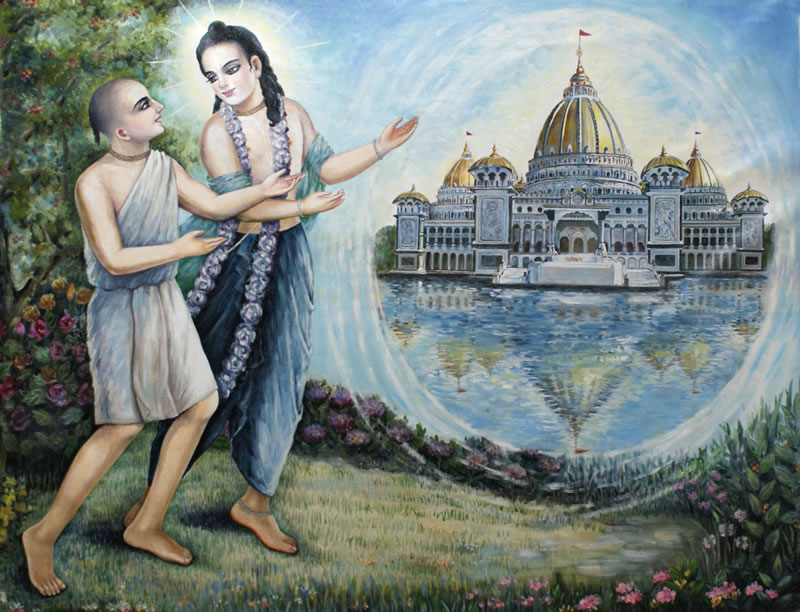
The Crest Jewel of the Gosvāmīs
Early Life
Śrīla Jīva Gosvāmī, the youngest of the Six Gosvāmīs of Vṛndāvana, appeared in 1513 CE in Ramakeli (present-day West Bengal) in a pious family of ministers serving under the Muslim ruler Hussain Shah. He was the nephew of Śrī Rūpa Gosvāmī and Śrī Sanātana Gosvāmī, the chief disciples of Lord Caitanya Mahāprabhu.
Even as a child, Jīva exhibited extraordinary devotion, composing prayers to Lord Kṛṣṇa and shedding tears of love while gazing at Deity forms.
Meeting Lord Caitanya (Indirectly)
Although Jīva Gosvāmī never met Lord Caitanya personally, he received His causeless mercy through Rūpa and Sanātana. When Lord Caitanya visited Ramakeli, young Jīva received darśana of the Lord from a distance. Overwhelmed with divine love, he resolved to dedicate his life completely to Śrī Caitanya’s mission.
Education and Training
Jīva Gosvāmī was highly educated in Sanskrit grammar, poetics, logic, and philosophy. He studied under Madhusūdana Vācaspati in Navadvīpa and later joined Rūpa and Sanātana Gosvāmīs in Vṛndāvana.
With their blessings, he mastered not only the bhakti-śāstras but also all branches of Vedic knowledge, which he used to defend the philosophy of Lord Caitanya.
Major Contributions
Philosophical Writings (Ṣaṭ-sandarbhas)
- Tattva-sandarbha
- Bhagavat-sandarbha
- Paramātma-sandarbha
- Kṛṣṇa-sandarbha
- Bhakti-sandarbha
- Prīti-sandarbha
These six treatises systematically establish the Gaudīya Vaiṣṇava philosophy of acintya-bhedābheda-tattva — simultaneous oneness and difference between the Lord and His energies.
Commentaries
- Authored the Laghu-toṣaṇī and Sarva-samvādinī, deep commentaries on Śrīmad-Bhāgavatam and the Sandarbhas.
- Clarified difficult points of earlier Gosvāmī writings and harmonized apparent philosophical contradictions.
Temple Development in Vṛndāvana
- Oversaw the service and protection of the Rādhā-Dāmodara Mandir, where his personal bhajana-kuṭīra still stands.
- Arranged for the preservation of manuscripts, safeguarding priceless Gauḍīya Vaiṣṇava literature.
Guiding Disciples and Scholars
- Trained numerous devotees, including Śrī Śyāmānanda, Śrī Narottama Dāsa Ṭhākura, and Śrīnivāsa Ācārya, who carried the message of Caitanya Mahāprabhu throughout India.
Achievements and Legacy
- Established the supremacy of bhakti over impersonalism through irrefutable logic.
- Ensured that Gaudīya Vaiṣṇava philosophy was recognized among traditional Vedic scholars.
- Preserved and expanded the mission of Rūpa and Sanātana after their disappearance.
- His writings remain the foundation for all Gaudīya Vaiṣṇava theology, studied daily in ISKCON and other Vaiṣṇava communities.
Disappearance
Śrīla Jīva Gosvāmī disappeared from this world in 1598 CE (Śaka 1520) in Vṛndāvana. His samādhi is located within the courtyard of the Śrī Rādhā-Dāmodara temple, where devotees still offer obeisances daily.
Real Spiritual Form
In the eternal pastimes of Vṛndāvana, Śrīla Jīva Gosvāmī is Vilāsa-mañjarī, one of the confidential maidservants of Śrīmatī Rādhārāṇī. In that form, he renders intimate service in the groves of Vraja, arranging for Rādhā and Kṛṣṇa’s loving pastimes.
Glorification by Vaiṣṇava Ācāryas
Śrīla Bhaktivinoda Ṭhākura and Śrīla Bhaktisiddhānta Sarasvatī Ṭhākura praised Jīva Gosvāmī as the greatest philosopher of his age and the guardian of the Gauḍīya sampradāya.
Śrīla Prabhupāda frequently referred to his Sandarbhas as essential for understanding Caitanya Mahāprabhu’s teachings in their pure form.
“By studying the writings of Jīva Gosvāmī, one’s devotion becomes mature, one’s understanding becomes deep, and one’s heart is filled with love for Śrī Śrī Rādhā-Kṛṣṇa.”
